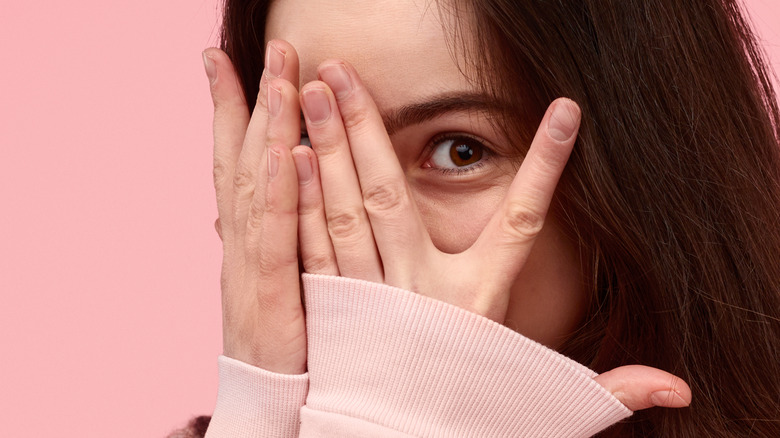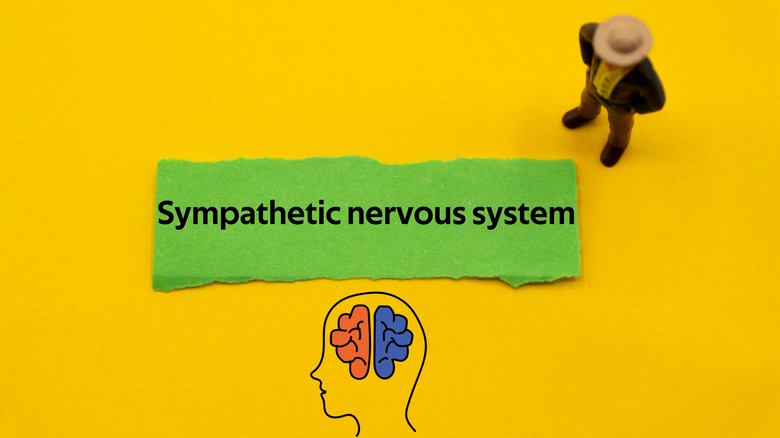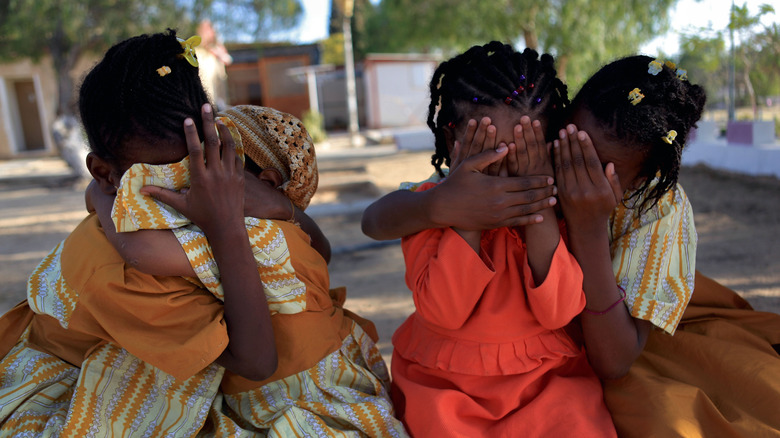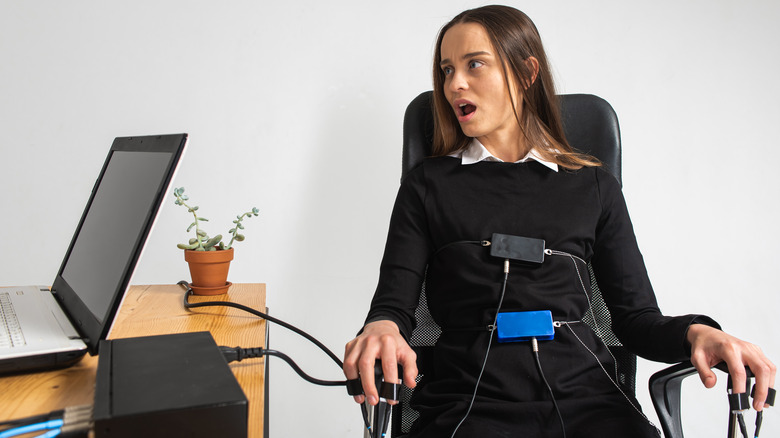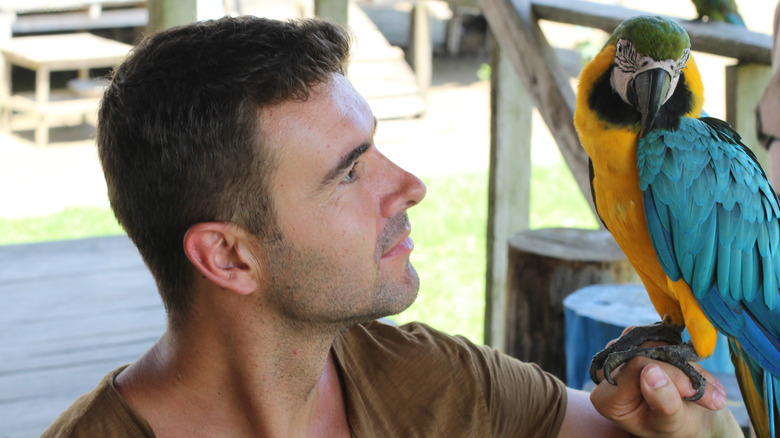The Scientific Reason People Blush When They're Embarrassed
Blushing is an uncontrollable reflex that allows others to understand our emotions. Rosy cheeks, face and neck are often triggered by the complex emotion of embarrassment. People who blush easily fear they'll be judged for it (via Behaviour Research and Therapy). While we know more than ever about how we blush, the question of why might always remain a mystery.
The father of evolution, biologist Charles Darwin, wrote extensively on blushing in his book "The Expression of the Emotions in Man and Animals." He found no evidence of this trait in the animal kingdom, describing blushing as "the most peculiar and most human of all expressions." As Darwin expounded, not only is the behavior involuntary, but telling someone they're blushing can actually increase the blush response. This observation was verified by scientists 137 years later (via Behavioral Research and Therapy). So, how and why is it that we get red, get read, and then get redder?
Being more sympathetic
Behaviors, voluntary and involuntary, are caused by the nervous system. The sympathetic side of our nervous system operates involuntarily and helps us respond to dangers in our environment by triggering the fight, flight, or freeze response (via Philosophical Transactions of the Royal Society of London). When an animal experiences threats or stress, the sympathetic nervous system releases chemical signals to prepare a defensive response (via Anatomy, Autonomic Nervous System). The hormone adrenaline is released, heart rate increases, pupils dilate, and supplies of blood are provided to certain regions of the body.
Our facial veins are unique in their sensitivity to nervous system signals (via Psychophysiology). Facial blood vessels are dense with adrenaline sensing receptors. When adrenaline is released, the vessel walls increase in circumference, allowing more blood flow in a process called vasodilation, and we blush. In times of distress or social discomfort, our thin and hairless face-skin lets everyone witness this whole physiological process.
Erythrophobia, the fear of blushing, is a recognized psychological diagnosis known to trigger social anxiety disorder (via Anxiety Disorders). In extreme cases, when therapy or other approaches have failed, a surgery called endothoracic sympathectomy can reduce blushing (via Postgraduate Medicine). During the surgery, some of the nerves of the face are snipped, cutting off nervous signaling and offering relief for people with erythrophobia and people who blush too much.
Blushing as a social signal
What embarrasses us changes from culture to culture, but according to the book "Shame Across Culture," a blushing response to embarrassment is a pan-human expression. It does not depend on culture or learning, and instead represents a key aspect of our social biology. The hard-wired nature of blushing was preserved over generations of evolutionary pressure. This means it likely serves an important function.
Stress and fear trigger our sympathetic nervous system, causing vasodilation. One major source of stress and worry is social interactions. It's likely that the dark complexions and denser hair of our early hominid ancestors obscured face reddening. Vasodilation of the face remained hidden like in other animals. Thus, the blushing of our faces could have developed before ancient primates had the smarts to interpret it. But as human facial skin changed and our brains grew, a brand new way of detecting the emotions of others was exposed.
Believe me, I'm sorry
If we violate a rule or expectation, it can anger people in our social group. Blushing allows us to display our emotional state and avoid aggressive interactions. When scientists reddened people's cheeks in photographs, study participants rated these individuals as being more embarrassed, sincere in their apologies, and were more likely to forgive them the redder their faces were colored (via Cognition and Emotion). When we blush, people can see that not only do we recognize our transgression, but we feel embarrassment, shame, and regret.
Blushing changes how we judge the actions of others. In one study, participants played a computer game against an unknown player who was actually fake (via Emotion). When the participant was betrayed by the fake player, scientists showed the participant a picture of their transgressor's face. Participants were more forgiving and likely to trust a blushing player, entrusted them with more play money, and predicted a lower likelihood the blusher would break their trust again.
Just like study participants used blushing to measure shame, perhaps our ancestors used blushing as a non-verbal social cue indicating contrition (via the book "Shyness and Embarrassment: Perspectives from Social Psychology"). Lots of animals have behaviors they use to avoid fighting, called signs of appeasement, and blushing is one of ours (via Aggressive Behavior). By using our furless faces and intellect, we can use blushing as a polygraph of someone's state of mind, and avoid unnecessary brawls.
Maybe we aren't unique, Darwin
For a while there, we thought we were pretty special. As our knowledge of the natural world grows, a smaller and smaller set of behaviors and characteristics can still be considered quintessentially human.
For over a century, there has been little evidence that other species share the social blushing behavior with humans. However, recently researchers working with large macaw parrots discovered facial flushing displayed by birds socially engaging with humans (via PLOS One). If it turns out other macaws notice and respond socially to fellow bird cheek color, then blushing might no longer be unique to humans, disproving Charles Darwin's assumption.
While we'll never know the exact pressures our early ancestors experienced that led to blushing becoming an integral social signal, we can still study the effect blushing has on social interactions. Researchers are also trying to understand what makes people blush too much and what treatments can be developed. The fact that it isn't just too many adrenaline receptors suggests that there is a psychological side of blushing we need to explore further (via Psychophysiology).
